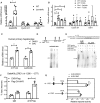Constitutive Activation of the Human Aryl Hydrocarbon Receptor in Mice Promotes Hepatocarcinogenesis Independent of Its Coactivator Gadd45b
- PMID: 30346592
- PMCID: PMC6358271
- DOI: 10.1093/toxsci/kfy263
Constitutive Activation of the Human Aryl Hydrocarbon Receptor in Mice Promotes Hepatocarcinogenesis Independent of Its Coactivator Gadd45b
Abstract
2,3,7,8-tetrachlorodibenzo-p-dioxin (TCDD), or dioxin, is a potent liver cancer promoter through its sustained activation of the aryl hydrocarbon receptor (Ahr) in rodents. However, the carcinogenic effect of TCDD and AHR in humans has been controversial. It has been suggested that the inter-species difference in the carcinogenic activity of AhR is largely due to different ligand affinity in that TCDD has a 10-fold lower affinity for the human AHR compared with the mouse Ahr. It remains unclear whether the activation of human AHR is sufficient to promote hepatocellular carcinogenesis. The goal of this study is to clarify whether activation of human AHR can promote hepatocarcinogenesis. Here we reported the oncogenic activity of human AHR in promoting hepatocellular carcinogenesis. Constitutive activation of the human AHR in transgenic mice was as efficient as its mouse counterpart in promoting diethylnitrosamine (DEN)-initiated hepatocellular carcinogenesis. The growth arrest and DNA damage-inducible gene 45 β (Gadd45b), a signaling molecule inducible by external stress and UV irradiation, is highly induced upon AHR activation. Further analysis revealed that Gadd45b is a novel AHR target gene and a transcriptional coactivator of AHR. Interestingly, ablation of Gadd45b in mice did not abolish the tumor promoting effects of the human AHR. Collectively, our findings suggested that constitutive activation of human AHR was sufficient to promote hepatocarcinogenesis.
Figures






Similar articles
-
Aryl hydrocarbon receptor expression and activity in cerebellar granule neuroblasts: implications for development and dioxin neurotoxicity.Toxicol Sci. 2005 Feb;83(2):340-8. doi: 10.1093/toxsci/kfi031. Epub 2004 Nov 10. Toxicol Sci. 2005. PMID: 15537747
-
Aryl hydrocarbon receptor knockout rats are insensitive to the pathological effects of repeated oral exposure to 2,3,7,8-tetrachlorodibenzo-p-dioxin.J Appl Toxicol. 2016 Jun;36(6):802-14. doi: 10.1002/jat.3211. Epub 2015 Aug 17. J Appl Toxicol. 2016. PMID: 26278112
-
Liver tumor promotion by 2,3,7,8-tetrachlorodibenzo-p-dioxin is dependent on the aryl hydrocarbon receptor and TNF/IL-1 receptors.Toxicol Sci. 2014 Jul;140(1):135-43. doi: 10.1093/toxsci/kfu065. Epub 2014 Apr 9. Toxicol Sci. 2014. PMID: 24718703 Free PMC article.
-
The aryl hydrocarbon receptor: studies using the AHR-null mice.Drug Metab Dispos. 1998 Dec;26(12):1194-8. Drug Metab Dispos. 1998. PMID: 9860927 Review.
-
Role of coactivators in transcriptional activation by the aryl hydrocarbon receptor.Arch Biochem Biophys. 2005 Jan 15;433(2):379-86. doi: 10.1016/j.abb.2004.09.031. Arch Biochem Biophys. 2005. PMID: 15581594 Review.
Cited by
-
Tryptophan fuels MYC-dependent liver tumorigenesis through indole 3-pyruvate synthesis.Nat Commun. 2024 May 20;15(1):4266. doi: 10.1038/s41467-024-47868-3. Nat Commun. 2024. PMID: 38769298 Free PMC article.
-
Prediction Model of Aryl Hydrocarbon Receptor Activation by a Novel QSAR Approach, DeepSnap-Deep Learning.Molecules. 2020 Mar 13;25(6):1317. doi: 10.3390/molecules25061317. Molecules. 2020. PMID: 32183141 Free PMC article.
-
Contradictory Role of Gadd45β in Liver Diseases.J Cell Mol Med. 2024 Dec;28(23):e70267. doi: 10.1111/jcmm.70267. J Cell Mol Med. 2024. PMID: 39653679 Free PMC article.
-
11-Cl-BBQ, a select modulator of AhR-regulated transcription, suppresses lung cancer cell growth via activation of p53 and p27Kip1.FEBS J. 2023 Apr;290(8):2064-2084. doi: 10.1111/febs.16683. Epub 2022 Dec 22. FEBS J. 2023. PMID: 36401795 Free PMC article.
-
Gadd45b is required in part for the anti-obesity effect of constitutive androstane receptor (CAR).Acta Pharm Sin B. 2021 Feb;11(2):434-441. doi: 10.1016/j.apsb.2020.08.015. Epub 2020 Sep 3. Acta Pharm Sin B. 2021. PMID: 33643822 Free PMC article.
References
-
- Balkwill F., Mantovani A. (2001). Inflammation and cancer: Back to Virchow? Lancet 357, 539–545. - PubMed
-
- Cole P., Trichopoulos D., Pastides H., Starr T., Mandel J. S. (2003). Dioxin and cancer: A critical review. Regul. Toxicol. Pharmacol. 38, 378–388. - PubMed
-
- Deshpande A., Sicinski P., Hinds P. W. (2005). Cyclins and cdks in development and cancer: A perspective. Oncogene 24, 2909–2915. - PubMed
-
- Ema M., Ohe N., Suzuki M., Mimura J., Sogawa K., Ikawa S., Fujii-Kuriyama Y. (1994). Dioxin binding activities of polymorphic forms of mouse and human arylhydrocarbon receptors. J. Biol. Chem. 269, 27337–27343. - PubMed

